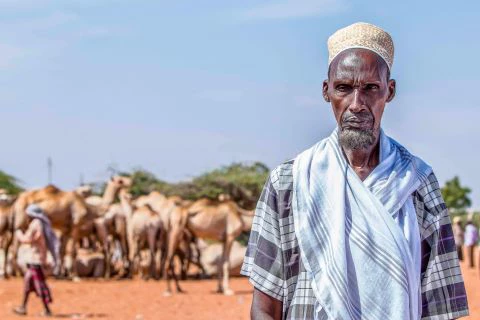 Man herding camels in Kenya
Man herding camels in Kenya
Armed conflict and violence seldom erupt overnight, even when their visible effects seem to take many off-guard. More likely, they stem from deep-rooted, entrenched fault lines that may not always be obvious or visible because they go back decades—if not longer. Effectively mitigating the eruption or recurrence of conflict requires identifying, analyzing, and tackling the root causes of fragility, conflict, and violence (FCV)—not just what happens but why it happens.
Structural factors of FCV are systemic characteristics that underpin a country’s economic, political, institutional, security, and societal evolution. They range from historical legacies and narratives to norms and values and include geography, subnational disparities, demographic trends, and many more. They may be simmering beneath the surface, deemed latent, as if no longer relevant or even self-evident, to the extent that one may not assess their full ramifications in the current context.
In the Lake Chad region, where armed conflict has been fueled by deep-rooted fragility and grievances, some groups, such as the “montagnards” from the Mandara Mountains and the Buduma, have been historically disenfranchised and still face regular barriers to representation in decision-making processes and development dividends. Geography is another important structural factor. As shown in the Lake Chad regional RRA with the exception of the capital N’Djamena, the Lake Chad region is remotely located which has fostered a sentiment of political isolation coupled with economic marginalization.
Past instances of armed conflict generate historical legacies, even when a generation or more has elapsed since violent events. Trauma, often inter-generational and collective, heals through acknowledging wrongdoings and reparative justice. In addition to direct survivors and families of victims, their descendants and the community at large can connect with the memory of violent events and how remnants of discrimination and stigmatization may still be perceived, long after these historical occurrences. Historical legacies shape a memory and group identity. It further contributes to a narrative where an individual’s access to opportunities may be interpreted through the lens of whether they belong to the group of former perpetrators or survivors.
While underlying, persistent patterns of exclusion and a sense of injustice feed into strong local feelings, collective narratives, and psyche about significant elements of a society, structural factors of FCV do not necessarily determine the trajectory of a region, country, or locality. They are instead constitutive to the history and fabric of a context and, as such, shape a core part of its specificity. Think of rhizome more than direct causality.
There are many examples of this. For instance, territorial imbalances greatly contribute to inequalities and grievances. Analysts point out a crisis of pastoralism at the heart of nomadic herders’ grievances in the Sahel, as well as zero-sum tendencies that prevent wider inclusion. Regional inequalities, between coastal and landlocked Saharan and Sahelian provinces, have various ramifications, such as on economic diversification, identity formation, and center-periphery relations.
Another example is the way in which governance systems inherited from colonial times have contributed to perpetuating contested and/or exclusionary patterns in settings affected by FCV. Guiding questions that may be helpful to unpack these connections include: To what extent did a colonial administration influence central or federal trajectories and power-sharing? Did independence occur as a result of a peaceful negotiation or from violent guerrilla warfare which institutionalized top-down, one-party “winner take all” mindsets? Did major milestones include and benefit all or only a few?
The recently completed Guinea Risk and Resilience Assessment (RRA) outlined the country’s experimentation with different forms of governance, such as socialism. The country’s exposure to various models has deeply influenced Guineans’ yearning for equality and their low acceptance of economic stratification, which can still be perceived today.
How can we adjust our lens not just to the last unconstitutional change of government but to review core features that have defined a country’s entire post-independence period? We cannot address the root causes of FCV unless we understand why events happen. This not only helps to mitigate their impact more effectively but also to prevent their recurrence in the future. Capturing structural factors of FCV entails augmenting a standard stakeholder mapping or conflict analysis with a recognition of these complex, intertwined connections, and the role of people’s perceptions in fueling deep-rooted grievances. In line with the World Bank Group Strategy for Fragility, Conflict, and Violence, it requires attention to the following:
- Mobilizing various disciplines to understand a society, its constitutive forces, and pressure points. Armed conflict and violence rarely arise simply because of economic failures and asymmetries. Rather, they stem out of power dynamics as well as actual and perceived exclusion factors. To measure them, one should understand that the structure of the economy, the country’s history, geography, culture, and social divisions, set entrenched patterns and require thinking outside the realm of traditional disciplines.
- Valuing people’s perceptions as much as objective measures of wellbeing and development. As the 2018 Pathways for Peace report demonstrated, inequalities and perceptions of exclusions between groups matter just as much, and often more, than inequalities between rich and poor. Perception and subjectivity play a critical role in shaping people's sentiments and appraisal of inequalities and exclusion. As such, it is often not only about what happened, but how it was perceived, interpreted, digested, and narrated by the people who experienced it. Therefore, one key challenge for practitioners is often one of data. Simply put, do we have the right data to dig deeper and wider
- Accepting the compounding and dynamic aspects of conflict and risks. Structural factors of FCV are mostly static but they are not relegated to the past. The extent to which these simmering attributes interact with the present makes them “living” and ever-present in the backdrop of fragile and conflict-affected situations.
This web of connections between past and present, structural, and more acute experiences of state formation and contestations, illustrates that societies are not frozen in time—they live, breathe, and evolve. They also remember. In addition to spatial, social, cultural, and economic features, structural factors of FCV influence path dependency—a historically-influenced course from which sets a rigid route—and behavioral patterns that unfold and repeat through time. They resist change and sometimes build up over time, like the sediment of a riverbed. If we don’t integrate them into a risk-informed approach and engagement, we, as development practitioners, miss critical depth and breadth, two essential parameters to effectively diagnose and tackle the root causes of FCV.



Join the Conversation